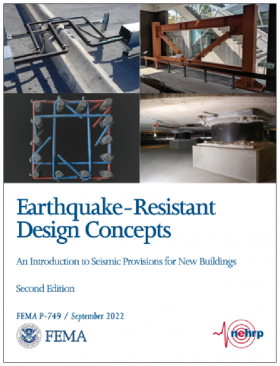FEMA P-749, Earthquake-Resistant Design Concepts: An Introduction to Seismic Provisions for New Buildings, provides an overview of earthquake-resistant design concepts and their context within the seismic requirements of U.S. building codes. Topics covered include: earthquake hazard fundamentals, the approach to seismic risk in current building codes, new concepts that could impact future seismic provisions, key design features for seismic resistance, and vulnerabilities of common structure types. The guide also includes a step-by-step walkthrough of seismic design process for new buildings embodied in the ASCE/SEI 7-22 Standard, Minimum Design Loads and Associated Criteria for Buildings and Other Structures.
Acknowledging that interest in the subject of earthquake-resistant design comes from both inside and outside of the structural engineering community, the FEMA P-749 report is divided into two parts.
- Part A, intended for a general audience, provides a non-technical explanation of the intent of U.S. seismic provisions and the key principles of earthquake-resistant design. This part is written for a wide audience, including elected officials, decision-makers in insurance and finance, building and business owners, and other interested members of the public. This part is also useful to engineers, architects, and other design professionals.
- Part B, intended for an engineering audience, presents the key steps in the seismic design process for new buildings. Background is provided on the major principles that serve as the foundation for the process, and special topics of interest are highlighted. The envisioned audience includes practicing engineers early in their career, practicing engineers new to seismic design, engineering graduate or undergraduate students, and architects. It is recommended that readers of Part B first read Part A.
